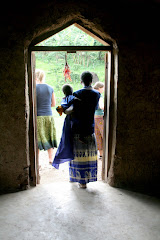
A photo of me holding Bright, the healthiest child in Uganda. Bright rarely smiles but chooses to show his affection in hugs and high 5's.
It’s been a couple weeks since my last posting and it is difficult to find where to begin. I guess I will start with our new volunteer Rotaract member Kristen Whitcomb who is assisting me in the assessment phase of the Rotary 3H grant! I picked her up at the airport in
Kristen and I woke early the next morning and caught the 6 am bus to Bwindi. Two breakdowns and 14 hours later we eventually arrived back at the guesthouse to BBQed steaks and peanut butter cookies prepared by the Danish med students Nadia and Karin and the IT expert Der (I guess its not all r oughing it out here). I think Kristen was absolutely wiped out but I shall let her explain in her own words.
oughing it out here). I think Kristen was absolutely wiped out but I shall let her explain in her own words.
Kristen has quickly taken to the role of field/lab technician processing the bacteria samples and generating data that will drive project implementation. Her quiet and supportive demeanor has been a very welcome change from juggling the finances, testing, and project planning for the Rotary 3H grant (the 3 H’s stand for Hunger, Health, and Humanity all directly related to clean water). She has even begun setting up her own experiments for UV treatment of contaminated waters as a possible at home measure to ensure clean drinking water (see photo on  right). Kristen has also wasted no time in getting acquainted with the multitudes of children here that sing at the top of their lungs "hello, how are you!" over and over again when they see a Mzungu. At this point I am thinking that a month and a half may not be long enough to have Kristen, I may have to keep her for the rest of the year!
right). Kristen has also wasted no time in getting acquainted with the multitudes of children here that sing at the top of their lungs "hello, how are you!" over and over again when they see a Mzungu. At this point I am thinking that a month and a half may not be long enough to have Kristen, I may have to keep her for the rest of the year!
To date we have collected fecal coliform data on 34 community drinking water sources including springs (protected and unprotected), surface water sources, gravity scheme sources (water piped from protected springs), and rainwater harvest sources. Thirteen of these sources were found to be under 10 cfu/100 ml. Sources greater than 10 cfu/100 ml is the contamination standard used by Life Water International. Our primary focus will be on those springs greater than 10 cfu/100ml. Obviously the most difficult situations are where there are no springs to protect and surface water is the only alternative.
 Once again the major issue appears to be available land. Driving back from a weekend away at
Once again the major issue appears to be available land. Driving back from a weekend away at
Just one anecdote before I leave you for another couple weeks. As I stated earlier I visited  lake is a ten thousand year old lake and is the deepest lake in
lake is a ten thousand year old lake and is the deepest lake in
Just 30 minutes outside of Bwindi I was confident that we would arrive at our destination without delay despite darkening clouds overhead… Just after we crossed the river we found that a ten ton truck had lost its brakes and drove up onto the embankment and turned over on its side blocking the entire road. Our driver, insistent on delivering us to our destination and heading back to his home that night decided he would drive across the nearby meadow, bypass the accident and get us back onto the road. The crux of our short detour was a steep ascent on slick muddy ground right before getting back onto the main road. The nearby onlookers viewing the accident were more than happy to assist us. As our driver approached the slope no less than 40 men and boys threw themselves against the back of our vehicle, rocking it up the incline and finally pushing the car up onto the road. It makes my heart ache to think that I didn’t have my camera with me to capture the moment. When we were back on the road it was time to settle up and I had a sinking feeling that the situation could get nasty. How do you pay a group of 40 people, I didn’t have any small bills on me better yet 40 of them? Is there any recourse if they ask for too much money? The group crowded around our driver arguing what the price should be. Thankfully the price that was demanded was 15,000 shillings which is about $10 however if they had demanded $100 I probably would have had to pay it. We left the scene of 40 men and boys cheering their good fortune at having landed such a prize. Nadia, Karin, and I could only smile in amazement at our good fortune and at the strength of


















